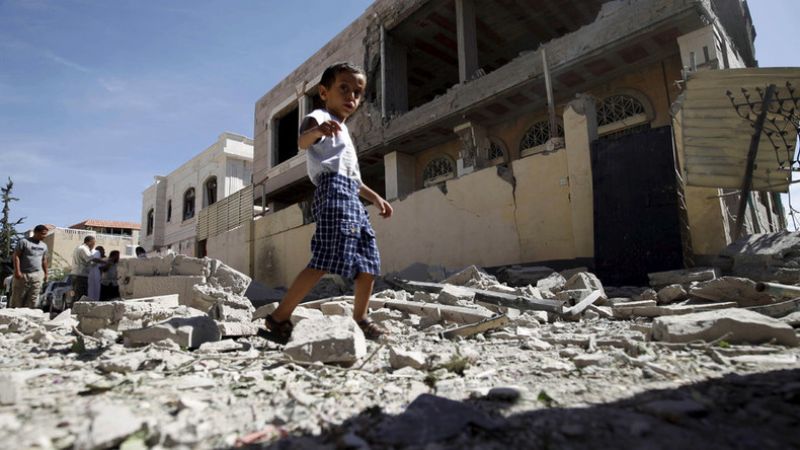
By Michael Igoe
At the start of the conflict in Yemen, which has now devolved into the world’s worst humanitarian crisis, U.S. officials worked behind closed doors to convince Saudi Arabia’s leaders not to target humanitarian and civilian sites for airstrikes.
Those efforts largely failed due to a lack of high-level political will within the Saudi government, according to two former U.S. officials who testified on Capitol Hill Wednesday.
“In the beginning of the war, we, at the State Department, thought that the best approach was to work with our partners, work with our allies behind closed doors, to build on the strong partnership that the U.S. had with Saudi Arabia,” said Dafna Rand, vice president for policy and research at Mercy Corps and a former deputy secretary at the Department of State.
In 2015, after a number of mass casualties from Saudi airstrikes against civilian targets, U.S. officials — who assumed these were the result of mistakes induced by the “fog of war” — sent a trainer to Riyadh to advise the Saudi government on how to limit civilian casualties, Rand said. This person had done the same kind of work on behalf of U.S. Central Command in Afghanistan.
“We approached this very technically, behind closed doors, very quietly sent our trainer in, and he was well-received by the Saudi ministry of defense, and we kept on trying this, and we were hopeful in the beginning, and we kept on sending him,” Rand said.
A ceasefire between the Houthi revolutionaries … and the Saudi-led coalition in 2016 offered U.S. officials some reason for optimism that their approach was working. Then, when the ceasefire broke down in August and a series of mass casualty events produced a new level of civilian bloodshed, it became clear that the message was not getting through.
The U.S. officials concluded that while many members of Saudi Arabia’s military wanted to learn from America’s experience with limiting casualties, leaders at the highest levels of government had much less political will to limit civilian targets and prevent civilian deaths.
“It was very clear that precision was not the issue, and that guiding was not the issue. It was the type of target selection that became the clear issue, and even when … the U.S. government told them which targets not to hit, we saw instances where the coalition was targeting the wrong thing,” Rand said.
The U.S. Agency for International Development was also involved in the process — particularly in terms of identifying areas and sites that the Saudis should not target with their airstrikes.
USAID put together a list of humanitarian sites such as NGO offices and warehouses — “things that, if you looked at them from the air, you might not be aware it’s a humanitarian facility. Whereas we assume you would know what a school looks like, what a hospital looks like, and so on, and not hit those things,” said Jeremy Konyndyk, a senior policy fellow at the Center for Global Development who directed USAID’s office of foreign disaster assistance during the Obama administration.
“What we found was that the Saudis tended to treat anything not on the no-strike list as fair game. So then we expanded the list, and we began naming specific categories of sites, including specific road routes that were critical to the humanitarian effort,” Konyndyk said.
In 2016, Saudi airstrikes targeted and destroyed bridges along the main road from the port of Hodeida to Yemen’s capital city, Sana’a. That road served as the principal transport route for humanitarian and commercial food shipments into the country.
“They struck that despite us having specifically told them through that process not to,” Konyndyk said.
Radhya Al-Mutawakel, a Yemeni human rights activist who leads the organization Mwatana for Human Rights, pointed out that when Saudi attacks produce mass civilian casualties, there is often not even a military target nearby that might explain the collateral damage.
“People themselves were asking why we were targeted,” Al-Mutawakel said. “That’s why it’s not a matter of training, it’s a matter of accountability. They don’t care. If they care, they can just make it much better,” she said.
The United States, as a key ally of Saudi Arabia and major arms supplier to the country, has both culpability and leverage in a conflict that has left 80 percent of Yemen’s population in need of humanitarian assistance, Konyndyk told lawmakers.
Applying that leverage will require more concerted effort at the highest levels of government.
“When the Saudis are doing something we don’t want them to do … asking them nicely while continuing to sell them arms has not yielded much progress,” Konyndyk said. “The only times we have seen progress has been when, at a very high level up to and including, at times, the president himself, when they put that request forward and make clear that it will have consequences for the U.S. bilateral relationship if it is ignored, then we see movement.”
Source: devex, Edited by Website Team